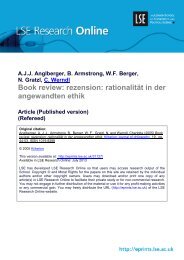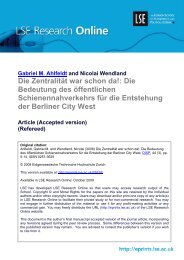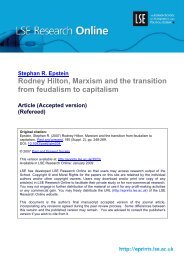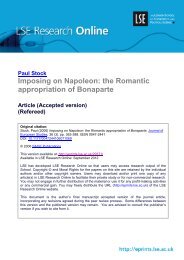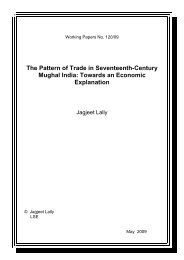Download (535Kb) - LSE Research Online - London School of ...
Download (535Kb) - LSE Research Online - London School of ...
Download (535Kb) - LSE Research Online - London School of ...
You also want an ePaper? Increase the reach of your titles
YUMPU automatically turns print PDFs into web optimized ePapers that Google loves.
Lemma 5.9 Let the random process (t) be de ned and continuous with probability 1 on the closed<br />
set F . Assume that there exist integers m r 2 and a number H such that for all t s 2 F<br />
Ej (t) ; (s)j m hjt ; sj r Ej (t)j m h:<br />
Then<br />
Efsup j (t)j<br />
t2F<br />
m g B0h (5.31)<br />
where B0 depends on m r and does not depend on .<br />
6 Second order expansions.<br />
Since by Lemma 5.6 Um = ;Bm + Vm + 1+<br />
m m, the expansion for Um requires one for Vm (4.8).<br />
This in turn requires one for Z =(Z1Z2) 0 , where Zi are given in (4.6) and de ned with ` = 3 in case<br />
<strong>of</strong> tapering and ` = 1 in case <strong>of</strong> no tapering. We assume in this section that (4.4) and Assumption<br />
m are satis ed. We shall derive the expansion <strong>of</strong> Vm in terms <strong>of</strong> e m( m).<br />
We shall approximate the distribution function P (Z x)x=(x1x2) 2 R2 ,by<br />
where<br />
F (x) =<br />
Z<br />
y x<br />
(y : )K(y)dy (6.1)<br />
(y : )=(2 ) ;1 j j ;1=2 exp(; 1<br />
2 y0 ;1 y) y 2 R 2 <br />
is the density <strong>of</strong> a zero-mean bivariate Gaussian vector with covariance matrix<br />
= e1+1 e1+2<br />
e2+1 e2+2<br />
= 1 ; 2<br />
;2 9<br />
where the elements <strong>of</strong> are de ned by (7.5) and related to Z1Z2 by<br />
E[ZpZv] =ep+v +2(m=n) e(p + v ` )+o( m) (6.2)<br />
(see Lemma 7.5). The polynomial K(y) isgiven by<br />
where P (2) (y), P (3) (y) are polynomials de ned by<br />
P (2) (y) =2<br />
Hij(y) = (y : ) ;1 @ 2<br />
K(y)=1+( m 1<br />
)<br />
n 2! P (2) ;1=2 1<br />
(y)+m<br />
3! P (3) (y) (6.3)<br />
2X<br />
ij=1<br />
@yi@yj<br />
e(i + j ` )Hij(y) P (3) (y) =2<br />
2X<br />
<br />
ijk=1<br />
(y : ) Hijk(y) =; (y : ) ;1 @ 3<br />
@yi@yj@yk<br />
Theorem 6.1 Suppose that (4.4) and Assumptions f l m hold. Then<br />
ei+j+kHijk(y)<br />
(y : ) i j k =1 2:<br />
sup jP (Z 2 B) ; F (B)j =<br />
B<br />
4<br />
3 sup F ((@B)<br />
B<br />
2 )+o(e m) (6.4)<br />
for any = m ;1; (0





